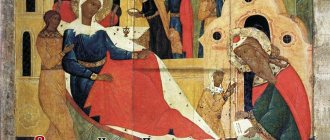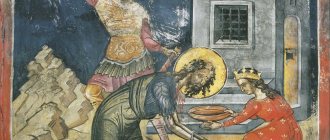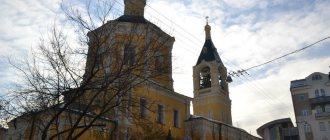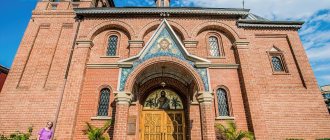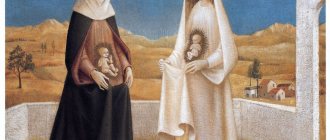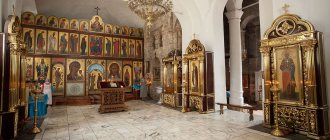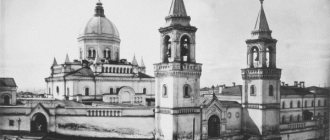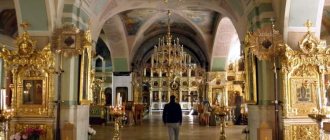On September 11, the Church celebrates the Beheading of the Prophet, Forerunner and Baptist of the Lord John. The day of the martyrdom of “the greatest of those born of women” is described by the evangelists Matthew (Matthew 14:1-12) and Mark (Mark 6:14-29). What happened to Herod next? Where is the head of the saint today? Why does fasting on this day mean becoming freer from slavery to pleasure?
After the death of Herod the Great, the Romans divided the territory of Palestine into four parts, appointing a ruler from among their proteges to each of them. Herod Antipas received Galilee under his control from Emperor Augustus. John the Baptist denounced the Tetrarch for the fact that, having left his legitimate wife (the daughter of the Arabian king Arethas), he illegally cohabited with Herodias, the wife of his brother Philip. For this, Herod imprisoned the saint. Some historians argue that Herod did this not so much out of anger at John the Baptist, but because he wanted to protect him from his beloved, knowing her vindictive nature. Herodias was extremely angry with the prophet.
The beheading of John the Baptist occurred during a feast in honor of Herod's birthday, which was attended by nobles, elders and commanders. Herodias' daughter Salome (Salome) danced in front of the guests, thereby winning over Herod, who vowed to give her everything she asked for - even half of his kingdom. At the suggestion of her mother Herodias, who had the opportunity to take revenge on Saint John and get rid of reproaches and accusations forever, Salome asked to give her the head of John the Baptist and bring it on a platter. Herod was embarrassed because he feared the wrath of God for killing the prophet, as well as the wrath of the people, since the Forerunner was loved by the inhabitants of Galilee. At the same time, it is known from the Gospels that Herod listened to Saint John in many respects and acted according to his words - but, as St. writes. John Chrysostom, the ruler “reigned over pleasures, or rather, was a slave to pleasures.” Chrysostom believes that, most likely, Herod covered himself with an oath as a plausible pretext - in fact, the true reason for his action was the fear of losing Herodias.
And he keeps his oath, given in the presence of distinguished guests: he gives the appropriate order - and the Beheading of John the Baptist occurs. There is a legend according to which the lips of the dead head of the prophet continued to denounce the ruler: “Herod, you should not have the wife of your brother Philip.” After this, Herodias, in a rage, pierced the prophet’s tongue with a needle and buried the head of the Baptist in an unclean place.
Herod continued to rule for some time after the Beheading of John the Baptist - the gospel story testifies that Pontius Pilate sent Jesus Christ bound to him (Luke 23:7-12).
The further fate of Herod and Herodias was sad. The lovers were afraid that Saint John would rise from the dead, and Herod, when he began to preach Jesus Christ, was horrified by this, saying: “This is John the Baptist; he rose from the dead, and therefore miracles are done by him.”
As time passed after the Beheading of John the Baptist, Salome, crossing the Sikoris River on ice in winter, fell under the water and the ice squeezed her in such a way that her head was on the surface and her body was in the icy water. She tried in vain to get out, but she did not succeed - this continued until sharp blocks cut her neck. Salome's body was not found, but the head was brought to Herod and Herodias, just as the head of John the Baptist was once brought. The beheading of John the Baptist also affected the fate of Herod himself - in revenge for the dishonor of his daughter, the Arabian king Arefa sent his troops against him. Herod was defeated and for this reason angered the Roman emperor Caligula. He was exiled with Herodias to prison in Gaul, and then to Spain.
After the Beheading of John the Baptist, his disciples buried the body of the saint in the Samaritan city of Sebastia. The holy head of John the Baptist was found and buried in a vessel on the Mount of Olives. Subsequent events developed as follows: one ascetic was digging a ditch for the foundation of a temple, found a shrine and kept it with him. And before his death, fearing that the shrine might be desecrated, he hid it in the ground in the same place where he found it.
In the year 452, the prophet indicated in a vision the place where his head was hidden - and it was again found, after which it was transferred to Emessa, then to Constantinople. In memory of this, another holiday was established, inextricably linked with the Beheading of John the Baptist - the discovery of his venerable head. The feast of the first and second miraculous discovery is celebrated by the Church on March 8 (February 24, old style).
During the time of iconoclastic persecution, the head was taken to Komani (Abkhazia), known as the place of exile and death of St. John Chrysostom, and hidden in the ground. After the restoration of icon veneration of St. Patriarch Ignatius at night during prayer was shown the place where the honest chapter was kept. Thus the shrine was found again. This event is celebrated on June 7 (May 25) as the Third Finding of the Head of St. John the Baptist
Who is John the Baptist?
Saint John in the Orthodox Church is called the Baptist, the great prophet, the Forerunner. In terms of the level of veneration in the Orthodox Church, Saint John the Baptist is in second place after the Mother of God, the Orthodox Calendar clarifies.
08 September, 6:44
What is the Presentation of the Vladimir Icon and what mystery does this holiday hold?
In 2022, the Orthodox Church celebrates the Presentation of the Vladimir Icon of the Mother of God on September 8. According to legend, this holiday is associated with the history of the salvation of Moscow from defeat by the army of Timur Tamerlane
“Forerunner” literally means “one who flows before”, “pioneer”, explains TASS. Saint John the Baptist is considered a great prophet who told people about the imminent coming of the Messiah - Jesus Christ - to the world. It was he who baptized the Son of God Jesus Christ in the waters of the Jordan River.
Common superstitions
The holiday has a long history, so many traditions are intertwined with pagan customs. For example, the Nativity of John the Baptist falls on the pagan holiday of Ivan Kupala. Thus, there are many superstitions associated with the celebration of the Beheading:
- Belarus. You can’t eat anything round, put round dishes on the table. Forks or knives should not be used during meals. The superstition is that, according to legend, the saint's head grows back to his body over the course of a year, but when people start using cutlery, it falls off again.
- Southern Slavs. You cannot eat or drink anything red, as it is the blood of St. John.
- East Slavs. It is strictly forbidden to keep meat in the house during the Beheading. This is due to the fact that the ancient pagans believed that meat meant executions and murders.
Superstitions have nothing to do with church traditions. The only thing the church requires is the observance of strict fasting.
What should you not do on the church holiday of September 11, 2020?
On the feast of the Beheading of John the Baptist, a strict fast is established in the Orthodox Church. This is how Christians express grief over the violent death of the great prophet. Believers should not eat meat and dairy products, eggs and fish.
In addition, on September 11, Christians refuse wine. And in churches on this day there are prayer services in which they ask God to grant sobriety - physical and spiritual.
You cannot get carried away by signs or perform occult and magical rituals. The Church always treats them negatively - both during important holidays and on ordinary days.
On the Feast of John the Baptist, believers attend divine services.
September 10, 7:48
history of the holiday
During the earthly life of John the Baptist, Palestine was occupied by Roman troops and divided into four kingdoms - this form of government is called tetrarchy. Herod Antipas, the son of King Herod, who killed fourteen thousand male babies in Bethlehem, reigned in Galilee.
A wicked branch from an evil root, King Herod left his lawful wife, the daughter of King Arethas, the Arabian ruler, and began to cohabit with Herodias, the wife of his brother Philip. By doing this, he violated the seventh commandment according to the law of Moses - do not commit adultery. In our debauched times it is almost impossible to comprehend the gravity of Herod's sin, but in those days the Jews stoned adulterers. Herod also sinned by incest; he should not have married Herodias even if his brother died, because Philip and Herodias had a daughter. Herodias not only did not oppose the rapprochement, but, on the contrary, favored this illegal relationship while her husband was alive.
Reproof of Herod Antipas
John the Baptist directly and openly pointed out to Herod his sin: “You must not have your brother’s wife” (Mark 6:16). Herod had previously known John, loved to listen to the prophet’s teachings and tried to act according to the commandment. However, when the Baptist began to denounce Herod for his illegal relationship with Herodias, the tetrarch ordered the righteous man to be locked in prison. Some historians claim that he imprisoned John, wanting to protect him from the wrath and retribution of the evil Herodias. In the Lives of the Saints of Demetrius of Rostov it is said that Herodias was especially angry with John, and would have wanted to kill him herself, but Herod protected the innocent prisoner. John Chrysostom says that the king was a “slave of pleasure,” therefore his intentions to live piously were very illusory.
John the Baptist spent many days in prison; disciples came to him and listened to his teachings. From the Gospel narrative it is known that the Prophet sent his followers to Jesus to ask: “Are you the one who is to come, or should we expect something else?” (Matthew: 11:3). He did this not because of weak faith, as Anthony of Sourozh believes, for example, in his Commentary on a group of verses: Mark: 1: 14-14. Demetrius of Rostov claims that John could not have not known who Jesus was, because he himself prophesied about the Lord - “Behold the lamb of God,” and did so for the sake of the disciples, so that they would personally be convinced of the Divinity of Jesus Christ.
Dance of Salome
Soon after the arrest of the righteous man, Herod celebrated his birthday. Many guests gathered - famous, rich. Herodias's daughter, Salome, danced for tipsy and effeminate sensualists, and pleased Herod so much with her shameless dancing that he promised any reward to the young dancer, up to half the kingdom. Salome turned to her mother for advice, and the embittered Herodias named the payment. It became the head of John the Baptist - the hermit, the righteous, the prophet, called in the Gospel an Angel (Matthew: 11:10) and the greatest of those born of women.
The tetrarch was ashamed to break his insane oath, he was ashamed of his guests, like every person, carried away by the blessings of this world, he was ashamed of weak people, and was not afraid of the Judgment of God, he neglected human life, the life of the great righteous man.
Previously, Herod was afraid of the people who considered John the Baptist a prophet, and opposed Herodias’s intention to kill him. Now, in a drunken stupor, the king was afraid to “lose face” in front of the guests. He immediately sent a guard to the prison with orders to bring John’s head on a platter, which he did.
Beheading of the head of John the Baptist
The murder of John the Prophet, like every atrocity, took place at night, since the feast took place in the evening (according to the words of the Evangelist Mark, “he held the supper with his prince”)
Herod's guests, seeing what had been done, were horrified. The murder sobered them up, the drunken noise died down. The head of the martyr, as suggested by Demetrius of Rostov, remained alive, bled and continued to denounce Herod. Salome took the head of the Saint to the evil Herodias, who accepted the coveted gift with satanic joy. Having violated the head, Herodias secretly buried it separately from the body in an unclean secret place. She did this out of fear that John would resurrect and continue to expose her sins. The body of John the Baptist was buried by the disciples.
Head of Saint John the Baptist
Herod, Herodias and Salome did not escape God's wrath. King Arefa, wanting to take revenge for his disgraced daughter, went to war against Herod. Herod lost the battle, which the Roman emperor Caligula did not tolerate, and the tetrarch was exiled to Gaul and then to Spain.
Salome crossed the Sycoris River, fell through the ice, and ice floes squeezed her neck until her head was cut off. Salome's dying body was swayed by the current, and it made dance movements. Those who saw this terrible death could not come to the rescue; they only picked up the girl’s head and brought it to her mother.
It is known about Herod and his wife that they “perished with a noise”, were swallowed up by the opening of the earth, which probably means death during an earthquake. Such is the terrible end of insane sinners.
Iconography
The existence of John the Baptist as one of the most significant figures present during the earthly life of Christ prompted icon painters to create a variety of subjects.
Historians distinguish 2 main types of images. The icons depict the very moment of the crime, when the executioners cut off John’s head. These are quite gloomy canvases, where a flying head is depicted, as well as blood gushing from the body. The main shades of the paintings are crimson, black, gold and brown.
In one of the most famous icons, the upper part of the canvas is decorated with the image of Jesus Christ, who looks at the crime and folds his hands in a blessing gesture. The central part of the upper field contains an inscription that states that a beheading is taking place.
The second plot is the image of the death head of the Forerunner. She rests on a dish covered with a white cloth. The predominant shades of the icons are white, blue, dark brown. The saint's face is pale, his eyes are closed. The darkest spots on the icon are John’s hair and beard. The background under the head is dark red; behind the central image, the icon painters paint an azure-colored curtain. There is an inscription above the head: “Head of St. John the Baptist."
Many paintings are dedicated to the tragic event. Many of them depict Salome dancing before the righteous man. Others depict the moment of the crime when a sword or knife is raised over the Baptist.
Notes[edit]
- Matthew 14:1–12, Mark 6:14–29, Luke 9:7–9
- Flavius Joseph. Jewish Antiquities
Archived April 19, 2007 at the Wayback Machine XVIII, v, 2. - Harmony of the Gospels, People's New Testament Commentary
- "Online Bible - New International Version". Biblehub.com
. 2011. Retrieved February 8, 2022. - Flavius Josephus, Antiquities of the Jews
18. 5. 2. (Translation by William Whiston). Original Greek. - "Calendar" . October 16, 2013
- Luke 8:3
- Ecclesiastical history
of Nikephoros I, ix. See Patrologia Graeca, cxlv.-cxlvii. - ^ a b Lost Worlds: Knights Templar
, July 10, 2006 History Channel video documentary, written by Stuart Eliot - ^ a b
"Benedict XVI, for a general audience, 29 August 2012" . Vatican.va. August 29, 2012 Archived from the original on July 18, 2014. Retrieved December 25, 2014. - Sean Martin, Knights Templar: History and Myth of a Legendary Military Order
, 2005. ISBN 1-56025-645-1 - Hooper, Simon (30 August 2010). “Are these the bones of John the Baptist?” . Cable News Network. Turner Broadcasting System, Inc. Retrieved August 31, 2011.
- ↑ a b
Aydın, Hilmi (February 16, 2010).
Sacred Trusts: Pavilion of Sacred Relics, Topkapi Palace Museum.
paragraph 150. ISBN 9781932099720. - ^ a b
Grima, Noel (25 July 2010).
"Restoring a Long Lost Connection". Independent Malta
. Archived from the original on March 15, 2012. Retrieved June 24, 2011. - Hamer, Galina Puntusova, David. "The History of the Priory Palace". history-gatchina.ru
. - “Cetinje - Old Royal Capital of Montenegro | Relics". City of Cetinje. Archived from the original on October 9, 2011. Retrieved June 24, 2011.
- "Monastery of St. Macarius the Great". www.stmacariusmonastery.org
. - Remains of John the Baptist Found, Archaeologists Claim Archived 2010-08-06 at the Wayback Machine, August 3, 2010
- "Reliquary of the Finger of St. John the Baptist - Nelson-Atkins Museum". Flickr
. - Text This Week
website , accessed February 11, 2007.
Relics [edit]
"Chapter of John the Baptist" redirects here. For the picture see Head of John the Baptist (painting).
The supposed head of Saint John the Baptist, kept in the Roman side chapel of San Silvestro in Capite, Rome. Muslim shrine dedicated to Saint John the Baptist, Umayyad Mosque, Damascus, Syria. Tari 1742 Knights Hospitaller coin showing the head of John the Baptist on a round silver platter.
According to ancient tradition, the burial place of John the Baptist was at Sebaste, near modern Nablus in the West Bank, and it is mentioned that his relics were venerated there around the middle of the fourth century. The historians Rufinus and Theodoret record that the shrine was desecrated under Julian the Apostate around 362, the bones being partially burned. Some of the rescued relics were transferred to Jerusalem, then to Alexandria, where on May 27, 395 they were laid in the basilica recently dedicated to John the Baptist on the site of the former temple of St. Serapis. Nevertheless, the tomb at Sebaste continued to be visited by devout pilgrims, and St. Jerome testifies to the miracles performed there. Today the tomb is located in the Nabi Yahya Mosque ("Mosque of John the Baptist").
It is difficult to determine what happened to the head of John the Baptist. Nikephoros [8] and Symeon Metaphrastus say that Herodias buried him in the fortress of Macherus (according to Josephus). Other authors say that he was buried in Herod's palace in Jerusalem; there it was found during the reign of Constantine and from there secretly transported to Emesa, in Phenicia, where it was hidden, a place remaining unknown for many years until it was revealed through revelation in 453.
Over the centuries throughout Christendom there have been many discrepancies in the various legends and claimed relics. Several different places claim to possess the severed head of John the Baptist. Among the various plaintiffs: [9]
- Roman Catholic tradition holds that the head on display at San Silvestro in Capita in Rome is the head of John the Baptist discovered for the second time [ failed verification
], as also claimed by Pope Benedict XVI in August 2012. [10] - According to Islamic tradition, the head of John the Baptist was buried in what was once called the Basilica of Saint John the Baptist in Damascus. Pope John Paul II visited the tomb of John the Baptist in the Umayyad Mosque during his visit to Syria in April 2001. Consequently, Muslims also believe that Jesus Christ will return to this place at the Second Coming.
- It was rumored in the Middle Ages that the Knights Templar owned the head, and many records of their Inquisition in the early 14th century mention some form of head veneration. [eleven]
- Amiens Cathedral claims that the head is a relic brought from Constantinople by Vallon de Sarton as he returned from the Fourth Crusade.
- Some believe that he is buried in Turkish Antioch or in the south of France. [9]
- G Reiki Orthodox John the Baptist in Jerusalem displays a fragment of the skull of John the Baptist. It is said to have been found during renovations to the church carried out in 1890.
- Considered [ by whom?
] that part of his skull is kept in the Romanian monastery of Prodromos on Mount Athos. - A reliquary at the residence in Munich, Germany, is noted as containing the skull of John the Baptist. [12]
Many other relics of John the Baptist are believed to exist, including the following:
- According to legend, Evangelist Luke went to the city of Sebastia, from where he took the right hand of the Forerunner (the hand that baptized Jesus) and brought it to Antioch, his hometown, where he performed miracles. It is reported that the relic will be taken out and shown to believers on the Feast of the Exaltation of the Holy Cross (September 14). If the fingers of the hand were open, this was interpreted as a sign of a bountiful year; if the hand were closed, there would be a crop failure (September 1 was the beginning of the liturgical year and harvest season).
- On January 7, the Orthodox Church celebrates the feast of the transfer of the right hand of the Holy Forerunner from Antioch to Constantinople in 956 and the Miracle of John the Baptist against the Hagarites on Chios.
- In 1204, after the Sack of Constantinople by the Crusaders, the Frankish Emperor Baldwin gave one bone from the wrist of Saint John the Baptist to Ottonus de Cichon, who in turn gave it to a Cistercian abbey in France.
- It is said that the hand of John the Baptist and part of his skull can be found in Topkapi Palace in Istanbul, Turkey. During the time of Mehmed the Conqueror, the skull was kept in Topkapi, and after his death, his stepmother Mara Branković, a Serbian princess, brought it to Serbia. It was then kept for some time in the Dionysius Monastery on Mount Athos, before the skull fragment was sent to a nearby island to prevent an outbreak of plague; however, the Ottoman fleet captured it and delivered it to Hassan Pasha of Algiers, who kept it in his home until his death. He was then returned to Topkapi. The skull is kept on a gold plate, decorated with gold stripes with precious stones and Old Serbian inscriptions. The plate itself is kept in a 16th-century rock crystal box. [13]
- The Hand of John was brought from Antioch to Constantinople during the time of Constantine VII. It was kept in the imperial chapel in the 12th century, then in the Church of the Virgin of the Pharos, then in the Church of Peribleptos in the first half of the 15th century. The Spanish envoy Clavijo reported that during his visit to Constantinople in 1404 he saw two different weapons in two different monasteries. With the fall of Constantinople, the Ottomans captured it. In 1484, Bayezid II sent the Knights of Rhodes here, and in return they captured his brother Cem. In 1585, Murad III brought weapons from Lefkosia to the castle of Constantinople (from now on Istanbul). The hand is kept in a silver reliquary decorated with gold. There are several inscriptions on the hand: “Beloved of God” on the index finger, “This is the hand of the Baptist” on the wrist and “Belongs to (the monk) Valley Monk” on the bandage above the elbow. [13]
]

